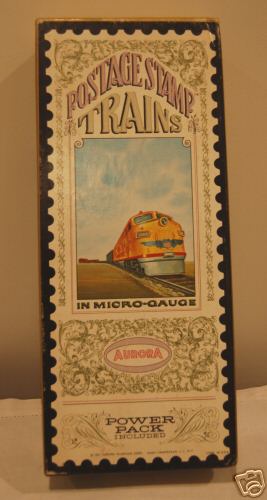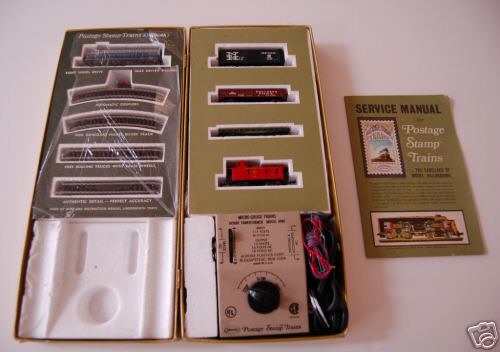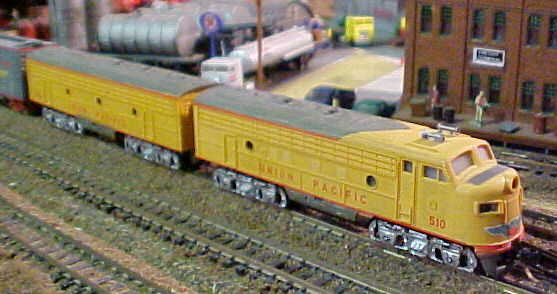

Introduced: circa 1966 (discontinued 1999)
These Minitrix locos were originally imported by Aurora under their "Postage Stamp" line. In fact, the F9 was the first American prototype locomotive Aurora imported from Minitrix (no, Virginia, the 0-6-0 "L'il Donkey" was not an American prototype). Aurora sold these ala carte or as part of train sets. The relationship between Minitrix and Aurora lasted for just a few years, and starting around 1972 ATI/Model Power became the new importer. In 1999, Minitrix was bought out by Marklin (another German outfit) and ultimatately the Minitrix F9 (along with Minitrix's entire line of North American N scale locomotives) vanished from the face of the earth.
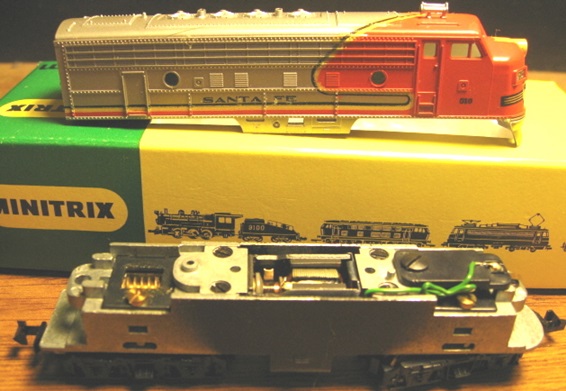
These are very decent running and looking models (particularly for their era). All four axles are geared, and all eight wheels provide pickup. Current is ferried to the motor via the chassis itself (IE, no wires). The three-pole motor provides fine, smooth speed control, including very respecatable slow speed creepability. The chassis is nicely hefty, making for very powerful pulling characteristics. And the mechanism itself is elegantly simple, making it quite easy to take apart and tune if need be. Yes, they run a little louder than we're used to nowadays (being a bit growly at higher speeds), but certainly nothing like some of the electric razors Bachmann (et al) foisted upon N scale back in the day. And yes, it has truck-mounted Rapido couplers, but what else would one expect from a 1967 design? Lastly, the wheel flanges are somewhat oversized, so these models will not run on Code-55 track.
Non-directional headlights on the A units were optional back in the Aurora days (with the Aurora catalog listing both lit and unlit versions, and with the former costing you a couple of bucks extra). I believe lighting became the norm in later years. The only other change I can detect in any of these is that the earlier versions came with metal truck gears, whereas later runs had plastic gears. I've compared the metal-geared versions to the later plastic-geared models, and honestly, I can't really tell any difference between the two. They both run and sound about the same.
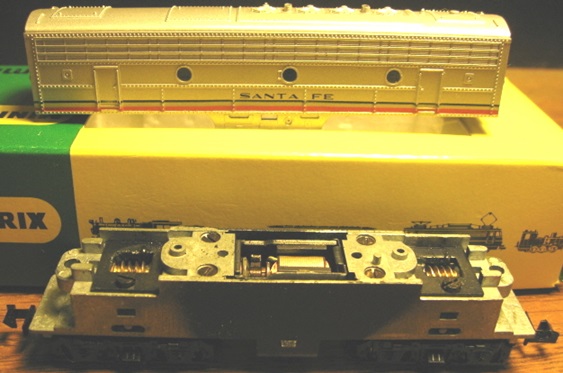
Old-time N scalers seem to have a soft spot in their hearts for these models, as I've heard many stories from people who bought these as kids and then proceeded to run them for decades. Proof-positive of Minitrix's seemingly bullit-proof design.
Both the "A" and "B" units were available in either "powered" or "dummy" configurations.
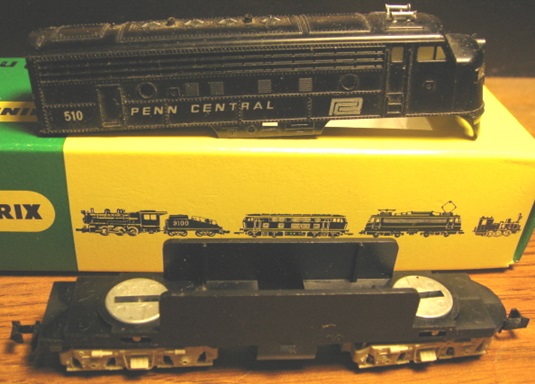
Minitrix marketed these as F9's, but the conventional wisdom is that the vent configuration on these is closer to that of an F7 than an F9.
Trivia- As mentioned above, "American Tortoise International" (ATI) imported these models in the 1970s (post-Aurora). That company later merged with PMI and became "Model Power" (circa 1977). Also, Con-Cor imported some of these models into the US and painted them in livery schemes unavailable from Minitrix. These were sold in Con-Cor packaging.
Grade: B
Reviewed: 1/69 Model Railroader ("Minitrix's road freight diesel is modeled after EMD's F9-series streamlined boxcab locomotive. The model has a good appearance even though its scale dimensions do depart from the prototype in several instances: The basic body is that of an F9, but it scales slightly under the length of the longer prototype FP9. The positioning of things such as the portholes, hatches and truck centers is varied. These deviations are not apparent when the model is placed next to one that is more exactly dimensioned. The ready-to-run model features a well-detailed molded plastic shell completely painted and lettered... The trucks are plastic screwed to a cast zinc alloy center frame. The power unit has a zinc alloy frame with a 3-pole DC motor positioned at the center. Brass worm gears engage large spur gears on each of the two trucks. These trucks have enough swivel play to permit running on 5"-radius curves. Two spur gears in each truck connect the drive to all four axles. The trucks are easily removed from the frame for maintenance by removing pins inserted crosswise through the frame and truck frame. The dummy unit has a plastic frame. Both units have illuminated headlights... Minimum speed is high, and the model is either stopped or going at least 10 to 15 scale MPH. The high maximum speed crowds all the control into one small section of the speed control. Our test sample pulled about 21 to 23 average-friction freight cars. The powered A units are $12.95 each in B&O, PRR, SF or UP livery and lettering. Dummy A and B units are priced at $4.98 each.")
Postage Stamp mania:
